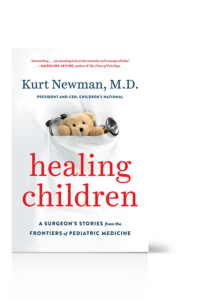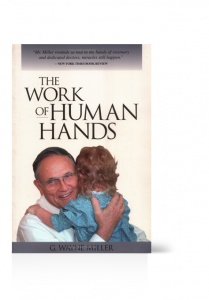Creating awareness.
About the challenges pediatric surgeons and their patients and families face every day.
About the book
While training to become a surgeon, I wrote The Child Surgeon. It is a very personal book about what Pediatric Surgery is today and what it means for our society. Above all, the book is about the love for pediatric surgery, in all its aspects.
The Child Surgeon as a book has become a huge success and received comments, feedback and inspiration from all around the world. Most importantly, readers expressed both a demand and a wish to engage in a global community for pediatric surgery. The book started this idea and lays its ground work.

The Child Surgeon is not a medical textbook. Also, it is not a book about my life in surgery. Instead, by recounting real patient stories and their heartbreaking fates, I explain the specialty of pediatric surgery to the interested lay reader and why it matters to any mature society.

Why I wrote this book.
“The reason I wrote The Child Surgeon is simple. Until now, I felt it was a book that was missing.”
In our public dialogue, we much debate the health of children and how to best take care of them in our society. For reasons unknown to me, this discussion has almost entirely neglected those children that require surgery to survive or heal. There are a few books that touch this vital subject, and that give some insight into individual parts of my specialty. I have made a reading list of these books for those interested.
In this way, The Child Surgeon may make its most important contribution: creating awareness about the challenges pediatric surgeons and their patients and families face today and simultaneously engaging in the discussion about how to make improvements. Although answers are not always obvious, perhaps the book can stimulate the incentive to bring together parents, surgeons, policymakers, the community, hospital administrators, and pediatric patients and contribute to the ongoing and much-needed public dialogue about improving the health of children.

About the Author
Although I often get recognised as a surgeon first, above all, I find myself a family man. Together with my wife María, who is a palliative care physician, we have two daughters. They mean the world to us.
I have always been fascinated by medicine and surgery involving children, but I did not quite understand its magnitude and importance until I became a father myself.
About the Foreword
Mike Chen wrote the foreword to The Child Surgeon.

Mike Chen
Mike is the surgeon-in-chief at the Alabama Children’s Hospital in Birmingham, Alabama.
Mike Chen was my fellowship director when I trained at Children’s of Alabama as a pediatric surgery fellow. When he agreed to review the book and write a foreword, I was delighted. Mike is more than a former boss to me. Mike is a teacher, a mentor, a role model, and one of the best surgeons that I had the privilege to work with. When I first met him upon starting my training in Alabama, his approach to surgery, was revolutionary to me. Like so many surgeons I have had the privilege to learn from, his hands and his dexterity were exceptional. Being still young, I had always thought that that is what it takes to be a successful surgeon. But Mike Chen had more. I could not pinpoint it at the time, but it became more and more evident to me over the years. He had a natural gift to outthink, to outsmart surgical disease. He taught me for the first time that the surgeon’s brain is more important than his hands. Of the many lessons I learned from him, this one has influenced the book the most.
We humans, including surgeons, make the same mistakes over and over again. If not corrected by external, systems-based algorithms, we engage in what is called heuristic thinking. What Nobel prize winner Daniel Kahneman described for humans in general, Mike taught me for surgery. Despite our best intentions, we oversimplify, we obsessively search for patterns instead and analyzing a situation in depth, we subconsciously cherry-pick information we look and hope for, and if we can’t find any, our brain makes them up. All this heuristic reasoning leads to bias and, subsequently to medical errors. Systemic, unconscious bias in medicine today is the main culprit for the lack of progress we have seen in recent years. Very rarely is this bias part of the education of medical students, let alone surgical trainees. This seemingly negligent attitude in and of itself proves my point. Bias, and the way we can control it, served as a silver lining through The Child Surgeon and was one the most exciting aspects about writing it.

Further Reading
The Child Surgeon was inspired in large by Atul Gawande’s writing in his book Complications: A Surgeon’s Notes on an Imperfect Science. His easy to read, story-based writing style did a lot to explain the imperfections and opportunities of surgery. In The Child Surgeon, I try to do the same with a focus on performing surgery on a child.
Apart from a large variety of medical textbooks, there are five other books that bring a narrative approach to the subject of pediatric surgery. All are good options for further, in depth reading on the topic covered in The Child Surgeon. I have pointed out a few similarities and differences of these books compared to The Child Surgeon.

Atul Gawande’s Complications: A Surgeon’s Notes on an Imperfect Science
(Profile Books Ltd; 2nd edition (27 Mar. 2008))
This is a stunningly well-written account of the life of a surgeon: what it is like to cut into people’s bodies and the terrifying – literally life and death – decisions that have to be made.There are accounts of operations that go wrong; of doctors who go to the bad; why autopsies are necessary; what it feels like to insert your knife into someone.

Catherine Musemeche’s Small: Life and Death on the Front Lines of Pediatric Surgery
(Dartmouth College Press; 1st edition (22 Aug. 2014))
As a pediatric surgeon, Catherine Musemeche operates on the smallest of human beings, manipulates organs the size of walnuts, and uses sutures as thin as hairs to resolve matters of life or death. Working in the small space of a premature infant’s chest or abdomen allows no margin for error. It is a world rife with emotion and risk. Small takes readers inside this rarefied world of pediatric medicine, where children and newborns undergo surgery to resolve congenital defects or correct the damages caused by accidents and disease. It is an incredibly high-stakes endeavor, nerve-wracking and fascinating. Small: Life and Death on the Front Lines of Pediatric Surgery is a gripping story about a still little-known frontier.

Alberto Peña’s Monologue of a Pediatric Surgeon
(2011, ISBN-10: 0984643214)
Peña’s book is a brief autobiography that describes the success of one particular surgery that he developed in the 1980s. While he gives readers some insight into his personal story of becoming a pediatric surgeon, he devotes little focus to the specialty itself, which is why it is a very different book compared to The Child Surgeon.

Kurt Newmann’s Healing Children: A Surgeon’s Stories from the Frontiers of Pediatric Medicine
(Penguin Books; Reprint edition, July 17, 2018)
Newmann’s book is a recent publication that is short and easy to read. It is addressed for a primary audience and does not require any medical knowledge. It gives a good insight into the current ongoings in pediatric health care in general but is very vague regarding pediatric surgery. Also, it focuses only on the US health care system, whereas The Child Surgeon takes an international point of view.

Wayne Miller’s The Work of Human Hands
(Random House; 1st edition, February 16, 1993)
Miller’s book is a biography of the pioneering Boston Children’s Hospital pediatric surgeon, Hardy Hendren, who worked there in the 1970s. The book examines some of the opportunities and limitations of pediatric surgery that The Child Surgeon discusses. Yet, these are instead byproducts of the primary narrative—Hendren’s career and his success of treating one particularly grave malformation within pediatric surgery called cloacal exstrophy. The Child Surgeon, meanwhile, looks across the field of contemporary pediatric surgery in an analytical, constructive, and readable fashion.

Children’s Surgery: A Worldwide History by John Raffensperger
(McFarland; 1st edition (February 23, 2012)
Compared to The Child Surgeon, this book is a medical history textbook and is purely descriptive, not analytical.

Donation
Make a donation to support our cause! All donations are used to nurture research in pediatric surgery and to improve the lives of children with surgical disease.
Thank you.
